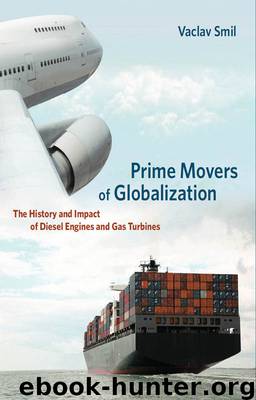Prime Movers of Globalization: The History and Impact of Diesel Engines and Gas Turbines by Smil Vaclav

Author:Smil, Vaclav
Language: eng
Format: epub, pdf
Publisher: The MIT Press
Figure 5.11
The massive fiber-and-resin blades of three large turbofan engines. General Electric’s GE90-115B; facing page: Rolls-Royce’s Trent 1000 and Pratt & Whitney’s GP7000.
Photographs available at the Web sites of GE Aircraft Engines, Roll-Royce, and Pratt & Whitney.
This old sixty-minute restriction, reflecting a much less reliable performance of piston engines, was enacted by the U.S. Federal Aviation Administration (FAA) in 1953, and it put most of the world’s oceans out of the reach of twin-engine jetliners (fig. 5.12). Most notably, it made it impossible for them to fly the shortest (great-circle) routes to serve the world’s busiest and most lucrative markets connecting North America and Europe. This rule was removed only when the indisputably proven reliability of modern turbofans made it possible to approve Extended-range Twin-engine Operational Performance Standards (ETOPS) that allowed flights that were longer than sixty minutes from diversionary airports, beginning with a Boston to Paris flight on February 1, 1985 (Bachtel 2003). The two-hour ETOPS greatly expanded the best connection opportunities by opening up virtually the entire North Atlantic for great-circle crossings and by rapidly making the twin-engine Boeing 767 the dominant trans-Atlantic airplane. Its use on these routes surpassed that of the four-engine Boeing 747 by 1993, and its weekly crossings now total over two thousand flights (Boeing 2006, 2009d).
Great-circle crossings of the North Pacific were next and in 1988 the ETOPS maximum was raised to three hours. This change was useful even in the North Atlantic, when one of the northern diversionary airports in Greenland or Iceland was unavailable due to bad weather. The PW 4000 was the first engine to qualify for the two-hour ETOPS even before entering the service, and the PW 4000-112 was the first engine approved for 207 minutes of ETOPS. In March 2000, it became possible to use twin-engine aircraft on routes where they would have to fly up to 207 minutes on a single engine to reach the nearest airport (Reich 2003).
Finally, I present a brief retrospective of the remarkable record of jet engines from their first working prototypes in the late 1930s and the early 1940s to their mature designs of the first decade of the twenty-first century. As with diesels, a lead indicator is a relentless rise in unit capacities—in this instance, measured in terms of maximum (takeoff) thrust (fig. 5.13). The extreme difference between von Ohain’s 1939 He S3B (rated at 4.4 kN) and the world’s most powerful aeroengine, General Electric’s GE90-115B (certified in 2003 at 512 kN and tested at as much as 568 kN) is two orders of magnitude (116-fold).
Other engine specifications follow with corresponding increases. The He S3B and Whittle’s W.2 had overall pressure ratios of, respectively, 2.8 and 4.4. By 1950, the Avon reached about 7.5; by 1970, the JT9D surpassed 20; by the mid-1980s, the ratios were over 30; and in 2003, the GE90-115B reached 42 (fig. 5.14). The air-mass flow of both Whittle’s and von Ohain’s design was about 12 kg/s while the GE90-115B handles about 1,360 kg/s. The dry mass of jet engines rose from 360 kg for the Hs S3B and 385 kg for the W.
Download
Prime Movers of Globalization: The History and Impact of Diesel Engines and Gas Turbines by Smil Vaclav.pdf
This site does not store any files on its server. We only index and link to content provided by other sites. Please contact the content providers to delete copyright contents if any and email us, we'll remove relevant links or contents immediately.
| American National Standards Institute (ANSI) Publications | Architecture |
| History | Measurements |
| Patents & Inventions | Research |
Whiskies Galore by Ian Buxton(41940)
Introduction to Aircraft Design (Cambridge Aerospace Series) by John P. Fielding(33093)
Small Unmanned Fixed-wing Aircraft Design by Andrew J. Keane Andras Sobester James P. Scanlan & András Sóbester & James P. Scanlan(32764)
Craft Beer for the Homebrewer by Michael Agnew(18198)
Turbulence by E. J. Noyes(7980)
The Complete Stick Figure Physics Tutorials by Allen Sarah(7338)
Kaplan MCAT General Chemistry Review by Kaplan(6900)
The Thirst by Nesbo Jo(6881)
Bad Blood by John Carreyrou(6583)
Modelling of Convective Heat and Mass Transfer in Rotating Flows by Igor V. Shevchuk(6406)
Learning SQL by Alan Beaulieu(6237)
Weapons of Math Destruction by Cathy O'Neil(6219)
Man-made Catastrophes and Risk Information Concealment by Dmitry Chernov & Didier Sornette(5957)
Digital Minimalism by Cal Newport;(5704)
Life 3.0: Being Human in the Age of Artificial Intelligence by Tegmark Max(5516)
iGen by Jean M. Twenge(5385)
Secrets of Antigravity Propulsion: Tesla, UFOs, and Classified Aerospace Technology by Ph.D. Paul A. Laviolette(5333)
Design of Trajectory Optimization Approach for Space Maneuver Vehicle Skip Entry Problems by Runqi Chai & Al Savvaris & Antonios Tsourdos & Senchun Chai(5037)
Pale Blue Dot by Carl Sagan(4956)
